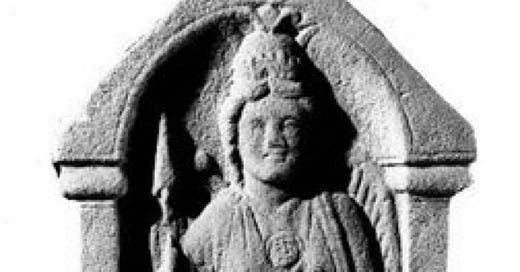Did Cumbria or the Romans create the symbol of Britain?
The ultimate emblem of British sovereignty, Britannia, is based on the 6,500 year old Cumbrian deity, Brigantia. Or so we thought. Did the Romans make her up as a piece of propaganda?
It is such an important historical fact that if it turned out to be fake, the British would be bewildered.
Britannia, the national personification of Britain as a helmeted female warrior in a silky dress holding a trident and shield, surely is genuine, isn’t she?
Up to now we have been led to believe then image that has appeared on our coins for hundreds of years was based on a Celtic Cumbrian goddess. Her name is Brigantia, and her origin can be traced back at least 6,500 years, or so we believed.
But now there is a growing school of thought that Brigantia may have been the cynical invention of Roman Emperor Septimius Severus.
They think he created her as a soulless piece of propaganda to bolster the loyalty of troops during the 208 AD campaign against Caledonian tribes in the north.
Suspicions are focusing on a Roman stone sculpture representing the native goddess of the Brigantes found at the Roman fort at Birrens in Dumfriesshire. That is twenty-six miles north of Carlisle where Severus established his summer camp for the four-year war against revolting Caledonians.
At Birrens, Brigantia is shown crowned and winged, holding a spear and a globe. The inscription reads: “Sacred to Brigantia: Amandus, the engineer, fulfilled the order by command”.
Amandus was in charge of refurbishing the fortress as part of Severus’s programme to rebuild the crumbling Hadrian’s Wall complex. There are, in all, seven inscriptions across Britain that mention the goddess Brigantia. Three are on altars in Yorkshire and three more appear along Hadrian’s Wall, including at Birrens.
The question of authenticity has arisen because it now seems the Romans encouraged the cult of Brigantia. It was not unknown for the Romans to promote of a local, native deity to a provincial protector.
It was also common practice for the Romans to co-opt, neutralise or attempt to “win over” Celtic gods so they would not be used by the rebellious locals to put a spoke in the Roman wheel. The idea was to create a sense of continuity in conquered people’s minds and suggest that the invaders have not eradicated the existing culture.
But the problem is that the statues seem to borrow attributes from several other goddesses, all favoured by the Severans. The statue of Brigantia appears to display aspects of Athena, the Roman goddess of war, Caelestis the goddess of justice, Juno the goddess of marriage and Minerva, goddess of victory.
The most sceptical historians argue that there was no physical evidence that Brigantia was a local deity before the Romans invaded. In fact, they claim, there was no trace of her apart from her name. Of course, this lack of evidence comes partly from the fact the Celts did not write anything down. It is also true that we do not know much about what Brigantia looked like in pre-Roman times because sculpture was not part of Celtic culture.
As historian Sheena McGrath noted in her book, Brigantia, “there is no tangible evidence that the goddess was a local deity, except her name. There is a school of thought which holds that Brigantia may very well have been a Roman creation, or at least so drastically remodelled by them.”
So, what the heck is going on?
Read the full story of how Brigantia became Britannia in a new book called Secrets of he Lost Kingdom.
You can pick up a copy from the New Bookshop on Main Street, Cockermouth. They are also available at the Moon and Sixpence, Lakeside, Keswick. You can get them at Bookends in Keswick and Carlisle, or Sam Read in Grasmere.
Or you can buy it instantly here:
https://www.fletcherchristianbooks.com/product/secrets-of-the-lost-kingdom
Keep reading with a 7-day free trial
Subscribe to Hidden Cumbrian Histories to keep reading this post and get 7 days of free access to the full post archives.








